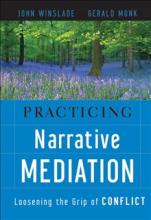One class from my MA studies at Eastern Mennonite University's Center for Justice and Peacebuilding which continues to stick in my mind is a course called "Narrative Negotiation." We learned about the roles of worldviews in negotiating solutions to conflict and how sometimes it's not the issues or proposed solutions that cause a problem in carrying out a successful negotiation, but because groups are coming from completely different ways of seeing the conflict. I see reflections of this both within the church and in larger conversations, especially around religion and culture. Since taking the class, I have repeatedly seen elements of what we studied come up in my life and work. To share a little about that, I've included here excerpts from a reflection paper I'd written for the class.
My story begins with the growing relationships I have had the opportunity to develop with students from Saudi Arabia. I am learning about the many diverse cultural narratives within the country that vary by region, urban or rural cultures, family cultures, generation, and education. Many young people who grew up as children of embassy workers stationed around the world, for example, or who have relatives that they have visited in Dubai, Australia, China, UK, New Zealand, USA, and other nations, relate to multiple cultural narratives. These worldviews often contradict typical assumptions of collective Saudi identity and culture.
In the midst of learning about the various worldviews represented by people I've gotten to know from Saudi Arabia, I received an email from an English teaching listserv with the title “Designing a ‘make-up’ class for our Saudi Arabian students.” The writer outlined previously attempted efforts to solve “problems with attendance and lack of follow-through with homework" through one-on-one meetings, probation, “discussing” withdrawal of the visa status required to remain in the United States, but lamented that “nothing seems to make an impact on the attitude or behavior.” The proposed solution was to create an extra class for students to make up missed assignments and class time and the writer emphasized that it would not be called "detention" as “that would set a negative tone.”
The email was followed by comments with a range of responses. Most of the emails either described a similar class or other ways they had dealt with the same problem. One post suggested that the administrators “make examples out of a couple of students” by cancelling their I-20 forms, without which students must return to their home countries. Following that post were several in agreement with the “example” response, and just two emails critiqued the approach directly. I was surprised to see that none of the responses questioned the definition of the problem, nor pushed back at the level of punitive measures suggested.
Since I had just finished the Narrative Negotiation course over the weekend, I decided to look at the thread again and see what I could observe from a narrative perspective. First, the wording of the initial question presented the problem in a technical manner (Docherty, 2010). A make-up class would be a solution for a short term technical problem defined as a matter of student time spent in class and completed homework. Second, the initial email used a specific whole story frame (Docherty & Caton Campbell, 2006), assuming agreement with the writer’s definition of the problem, and focusing on fine-tuning the solution. In essence, the first writer had stabilized the story (Winslade & Monk, 2008), making it difficult for other stories to arise without reframing. Also, by describing in detail all of the efforts of the administration to “accommodate” students, try multiple approaches, keep a positive tone, and show concern for the students’ “progress” in language learning, the writer of the first email implicitly positioned students as unmotivated, uncooperative, and even ungrateful. This discursive positioning made it difficult for anyone to respond without repositioning the writer (Winslade & Monk, 2008). Furthermore, many writers throughout the thread used essentializing language (Winslade & Monk, 2008), describing Saudi learners as “less-motivated,” “problem-students,” or “slacking off.” This type of language placed the problem within the learners themselves rather than as a conflict arising through social interactions or a contrast of cultural narratives.
Double listening might be helpful in reading this thread as well (Winslade & Monk, 2008). What are the underlying concerns? What values are implicit in the posts? In the initial email, I can clearly see a desire to help all students achieve their goals and learn English successfully. There is a willingness to keep trying with the students from Saudi Arabia and not give up. The writer also seems to value positivity and fairness as part of the process. These elements that are revealed by looking at the opposite of what is said could be helpful for responding to the writer in a way that opens up possibilities for other stories.
Returning to the listserv a week later, I found several more nuanced, longer posts on the thread. Many of the writers were from outside the United States and seemed to be more familiar with recognizing multiple cultural narratives. I was glad to see that others who read the emails had also asked a lot of questions about culture, narrative, and approaches to negotiation. Reflecting on this email from a narrative negotiation perspective was a reminder to me to continue listening and to remember to consider the limits of my worldviewing and how it might be affecting negotiations with students or administrators in an English educational context. I wonder how I might better engage the multiple cultural narratives I encounter, and how I can be an encouragement to other educators who might be stuck in a particular way of trying to negotiate.
References
Docherty, J. S. (2010). "Adaptive" negotation: Practice and teaching. In C. Honeyman, J. Coben & G. De Palo (Eds.), Venturing beyond the classroom (Vol. 2, pp. 481-509). St. Paul, MN: DRI Press.
Docherty, J. S., & Caton Campbell, M. (2006). What's in a frame? In C. Honeyman & A. K. Schneider (Eds.), The negotiator's fieldbook: The desk reference for the experienced negotiator (pp. 37-46). Washington, D.C.: American Bar Association.
Winslade, J., & Monk, G. (2008). Practicing narrative mediation: Loosening the grip of conflict. San Francisco, CA: Jossey-Bass.



Add new comment
Canadian Mennonite invites comments and encourages constructive discussion about our content. Actual full names (first and last) are required. Comments are moderated and may be edited. They will not appear online until approved and will be posted during business hours. Some comments may be reproduced in print.